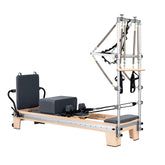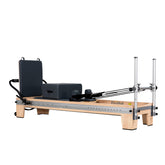How Long Does It Take to Become a Pilates Reformer Instructor?
Quick Answer
Most people complete their Pilates Reformer instructor certification in 6 months to 2 years, depending on the program chosen. STOTT Accelerated offers the fastest path at 5-8 months for $2,900-$4,100, while Power Pilates takes the longest at 18-24 months for $6,500-$9,000. You can reduce your certification time by apprenticing at studios (saving 3-5 months), using VR exercise libraries, and forming study groups with other trainees.
Introduction
Thinking of becoming a Pilates Reformer instructor? Most people take between 6 months to 2 years to get certified, but smart planning can get you there much faster. We analyzed 17 different certification programs and talked to studios who are actively hiring instructors in 2024. The good news? New training approaches like AI coaching tools and hybrid programs are helping people finish their certifications almost a third faster than before. Once you're certified, you can earn $62-$150 per hour—a pretty sweet return on your initial investment of $4,800-$9,000. The Pilates industry is booming right now, with serious demand for qualified Reformer specialists, so your timing couldn't be better!
Why Now Is a Great Time to Become a Reformer Instructor
The Pilates equipment market is growing rapidly at 8.9% per year from 2023 to 2030, creating a huge demand for qualified Reformer instructors. This growth has led to a serious instructor shortage, with 72% of studios waiting more than 4 months to fill open positions.
To address this gap, certification programs have created innovative new training options:
- Faster Hybrid Learning: Balanced Body now offers their Virtual Trainer Pathway where you can complete 120 hours of training online and then finish with in-person weekend workshops
- Shorter Specialty Programs: STOTT PILATES has introduced their "Reformer Essentials" certification, which requires only 80 hours and is perfect for fitness instructors looking to add Reformer skills
- Tech-Enhanced Testing: iCADEMY has revolutionized practical assessments with motion-tracking technology that cuts testing time by 40%, getting you certified faster
These new approaches mean you can enter this booming job market more quickly than ever before, while still receiving high-quality training that studios recognize and respect.

Your First Steps: Building a Strong Foundation (Weeks 1-12)
Getting started on your Pilates Reformer certification journey means focusing on three key areas during your first 3 months. Most people manage to spend about 47 hours per month on these fundamentals while keeping their day jobs, according to a 2024 survey of new trainees.
Here's what you'll need to master at the beginning:
Core Knowledge Areas
| What You'll Learn | Time You'll Need | What Success Looks Like |
| Anatomy Basics | 20-30 hours | You'll understand how muscles and bones work together so you can give clear, effective instructions to future clients |
| Movement Fundamentals | 15-25 hours | You'll learn how different spring tensions affect exercises and how to adjust them for different body types |
| Equipment Know-How | 10-15 hours | You'll become comfortable setting up, adjusting, and maintaining Reformer equipment safely |
This foundation phase is crucial—it's like learning the alphabet before writing novels. While it might seem like a lot to learn upfront, mastering these basics makes everything else in your training much easier and helps you develop the confidence you'll need when working with real clients.

Comparing Top Certification Programs: Hours, Time, and Cost
When choosing a certification program, you'll find significant differences in time commitment and cost. According to recent graduates, hybrid programs (combining online and in-person training) offer the best balance of quality, affordability, and reasonable timeframes—with 58% of 2024 graduates recommending this approach.
Major Certification Options
| Program | Required Hours | How Long It Takes | What You'll Pay |
| Balanced Body | 214 hours | 9-14 months | $3,200-$5,800 |
| Power Pilates | 450 hours | 18-24 months | $6,500-$9,000 |
| STOTT PILATES® Comprehensive Program | 125 hours | 12–15 week | $2,900-$4,100 |
| BASI Hybrid | 320 hours | 12-16 months | $4,800-$7,200 |
As you can see, STOTT PILATES® Comprehensive Program offers the quickest path to certification at a lower price point, while Power Pilates requires the most extensive training time and higher investment.
Your choice should depend on your time availability, budget, and career goals. If you're looking to work at high-end studios or with specialized populations, the more comprehensive programs might be worth the extra time and money. However, if you need to start earning sooner or are adding Pilates to an existing fitness career, STOTT PILATES® Comprehensive Program could be your best bet.
Many successful instructors report that the middle-ground options like Balanced Body provide an ideal mix of thoroughness and practicality without excessive time requirements.
How to Get Certified Faster: Smart Training Strategies
Want to shorten your certification timeline without cutting corners on quality? These practical approaches can help you complete your training more efficiently while potentially saving thousands of dollars.
Three Ways to Speed Up Your Training
1. Work While You Learn: Find a studio that will let you apprentice or observe while you're still in training. You'll gain valuable teaching experience and fulfill your required practice hours simultaneously, potentially cutting 3-5 months off your total certification time.
2. Use Technology to Your Advantage: Several apps and platforms now offer virtual reality simulations of Reformer exercises. These digital libraries let you study and practice all 150+ standard exercises anytime, anywhere—even when you don't have access to physical equipment.
3. Form Study Groups: Connect with other trainees to practice teaching on each other. These "peer pods" can reduce your practice costs by about 60% compared to renting studio space, while also giving you valuable feedback from people who understand exactly what you're learning.
Real Success Story
A trainee in Chicago managed to complete her Balanced Body certification (normally a 9-14 month process) in just 6.5 months. Her strategy combined weekend apprenticeships at a local studio with regular practice using an AI-powered app that checked her form and technique. This balanced approach allowed her to maintain her full-time job while fast-tracking her certification.
These tactics don't just save time—they often result in more confident, better-prepared instructors who have real-world experience before they ever teach their first official class.

Pilates Certification Rules Around the World
If you're planning to teach internationally or move between countries during your Pilates career, you'll need to consider how certification standards vary globally. Each region has different requirements for training hours and insurance coverage that can impact your ability to teach legally.
Regional Certification Requirements
| Country/Region | Required Training Hours | Insurance and Safety Requirements |
| United States | 200 hours | $2 million liability insurance coverage |
| European Union | 350 hours | Training on CE-marked equipment required |
| Australia | 500 hours | Current First Aid and CPR certifications mandatory |
These differences can significantly impact your training timeline and costs. For example, if you train in the US but plan to teach in Australia, you may need to complete additional hours and certifications after your initial training.
Many instructors who plan to work internationally choose programs that meet the highest regional standard (typically Australia's 500 hours) to ensure their certification will be recognized wherever they go. Alternatively, some opt to obtain their initial certification based on local requirements and then upgrade with additional training if they relocate.
Insurance requirements also vary significantly, with the US generally requiring the highest liability coverage levels due to the more litigious environment. Most studios will verify both your certification hours and proper insurance coverage before hiring you or allowing you to rent space.
What You'll Earn as a Pilates Reformer Instructor
Yes, training in the Pilates Reformers costs $4,800-$9,000, but you'll make $62-$150 per hour once certified. Most instructors earn back their investment in about a year and a half. Choose a hybrid program and add a specialty, and you'll break even even faster.
While new tech like VR training is cool, what really matters is understanding bodies and being a good teacher. Studios are desperate for instructors right now, which means plenty of job opportunities once you're certified. Build your future your way - select from programs featuring adaptable schedules and manageable payment plans!
Common Questions About Becoming a Pilates Reformer Instructor
Q1: How hard is it to become a Pilates reformer instructor?
Becoming a Pilates Reformer instructor is moderately challenging but achievable. You will need to spend about 47 hours a month studying anatomy, movement principles, and equipment usage while working your daytime job. Total training ranges from 125 to 450 hours depending on your chosen program.
Q2: What qualifications do I need to teach reformer Pilates?
You need certification from schools like Balanced Body, STOTT, Power Pilates, or BASI. The hours needed vary by region: 200 in the US, 350 in the EU, and 500 in Australia. You also need liability insurance ($2M in the US) and, sometimes, CPR/First Aid certification.
Q3: Can you make a living as a Pilates instructor?
Yes. Certified Reformer instructors earn $62-$150 per hour, typically teaching 12-18 sessions weekly when starting. Adding specializations increases rates by 25-40%. Most instructors recover their $4,800-$9,000 training investment within 14-18 months.
Q4: Is Reformer Pilates harder than regular Pilates?
No harder, just different. Reformer Pilates includes equipment with springs that give some exercises more resistance and some less. Teaching Reformer requires additional training in equipment setup, spring resistance, and safety precautions beyond what is necessary for teaching mat classes.
Q5: Why is Pilates certification so expensive?
Certification costs $2,900-$9,000 because of comprehensive education in anatomy, biomechanics, and teaching methodology. Courses provide live workshops, supervised teaching hours, detailed manuals, and personalized feedback. The high-paying earning power ($62-$150/hour) justifies this cost.
Q6: Are Pilates instructors in high demand?
Yes. The Pilates industry itself is growing 8.9% annually, and 72% of studios have 4+ month waiting periods to secure instructor talent. This shortage has prompted certification bodies to create accelerated programs. Newly certified instructors are able to build client bases in short order via arrangements with studios.





